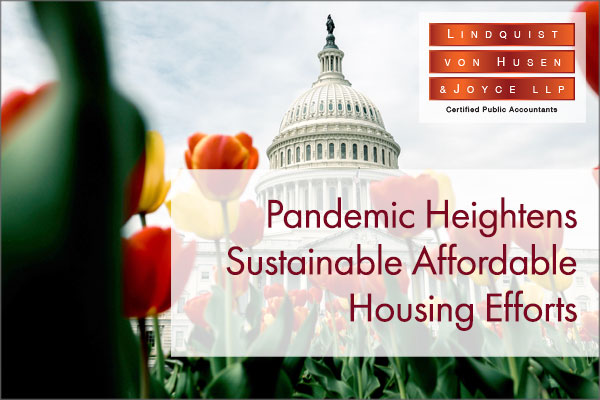
Since the PATH Act in 2015, no major federal legislation has come about to address massive shortages in affordable housing across the U.S.
While the House and Senate introduced many bills since then, legislation seems to die in committee or across the aisle. Much more legislation is enacted at the state level, but we know that new affordable housing can be a tough sell at the neighborhood level. There is still a public perception that multi-unit housing and increased housing density lead to lower property values.
The pandemic is a fork in this road.
Affordable housing is not simply a need for the poorest families, but also among families who have seen wages fail to keep up with the cost of living even as rents in good job markets skyrocket. Ironically, they include the construction laborers who build housing. Millions of people with job losses now join existing housing insecure families. Recent federal and state eviction bans offer only short-term relief of potential homelessness and population migration until the new year.
Advocates for tenants and the real estate industry worry that eviction bans are not enough, and they are calling for federal aid for renters and property owners affected by the pandemic to avoid mass evictions and property owner sales or foreclosures.
Who Pays for the Lack of Affordable Housing?
As we’ve seen with recent corporate offers of billions in private funding for more affordable housing, employers of all sizes end up paying for its absence because they can’t recruit new talent to high-cost housing areas of the country.
Lack of affordable housing also impacts the economy, as families have less disposable income to spend on goods and services.
Society at large and the leaders who represent it end up paying a price, too, with homeless tent cities and public unrest. We’ve learned through studies by the Urban Institute that home insecurity is a contributing factor to family dysfunction, truancy and child neglect.
Continue Pre-Pandemic Efforts to Sustain Affordable Housing
Prior to the COVID-19 pandemic, many states were making headway toward developing and rehabbing affordable housing. These efforts continue, and some promising efforts include:
- Providing incentives for cities and counties to plan for and develop sufficient affordable housing through state budget measures
- Creating or extending state LIHTC programs
- Encouraging owner recapitalization and rehab of Year-15 and Year-30 properties, especially where affordability is lowest
- Limiting the ability of local jurisdictions to change development standards or zoning laws immediately after preliminary applications are submitted for affordable housing projects
- Limiting the number of public hearings or requests for information that can drag out preliminary application approval processes for higher density housing
- Expediting the approvals process for qualifying organizations to move homeless individuals or families into permanent or supportive housing
- Increasing access and funding to Public Housing Authorities (PHAs) to provide housing assistance or subsidy to families who qualify
With homelessness deemed a crisis in cities prior to COVID-19, the pandemic’s impact on at-risk households can only worsen this crisis. Developers, investors, policy advocates and legislators should assertively continue the pursuit of new projects through both public and private investment and policy channels as well as sustaining existing projects through strategic use of tax credit and rehab programs. But there should also be support for the developers themselves to identify and mitigate their risks.
If you are an owner, a developer or the CFO of a property management company involved in affordable housing efforts, our team at LvHJ is ready to help you succeed. We are helping to update a risk identification matrix for developers to assess and mitigate their future risks. It’s part of our firm’s long involvement and dedication to StrengthMatters and the affordable housing industry.
Consider attending our quarterly, virtual CFO roundtables. See our roundtable summary and webinar recording about the CARES Act impact on affordable housing entities.
Sources:
HUD Office of Policy Development & Research (PD&R) – https://www.huduser.gov/publications/pdf/what_happens_lihtc_v2.pdf
National Low Income Housing Coalition – https://reports.nlihc.org/sites/default/files/gap/Gap-Report_2020.pdf
Holland & Knight law firm – https://www.hklaw.com/en/insights/publications/2019/10/californias-2020-housing-laws-what-you-need-to-know
Multihousing News – https://www.multihousingnews.com/post/covid-19s-impact-on-multifamily-and-affordable-housing/
Urban Institute – https://www.urban.org/sites/default/files/publication/100292/how_housing_matters_for_families_1.pdf








